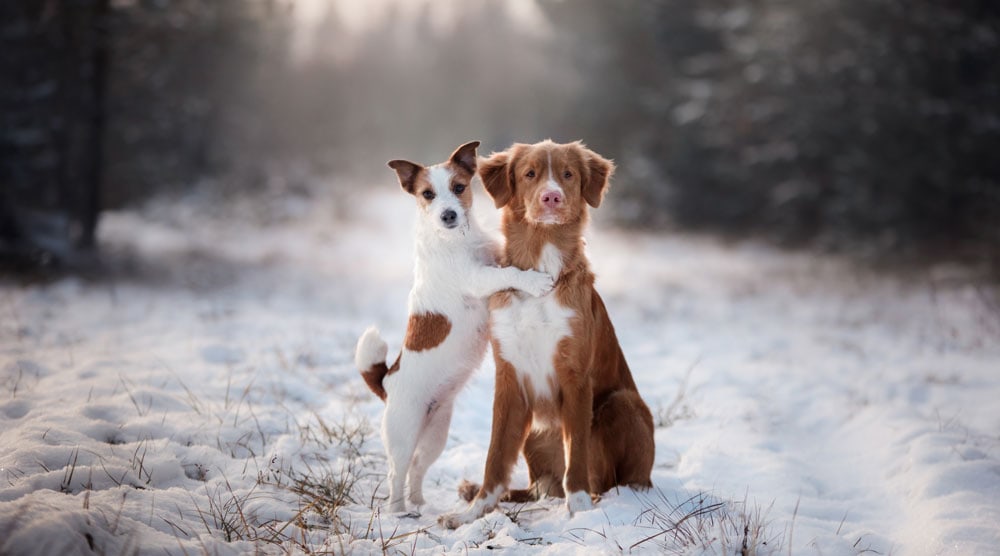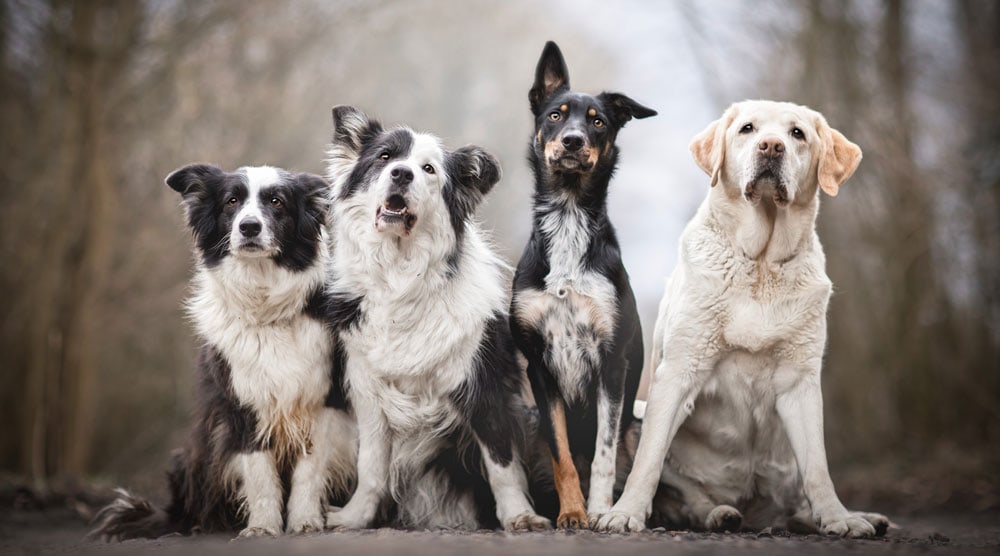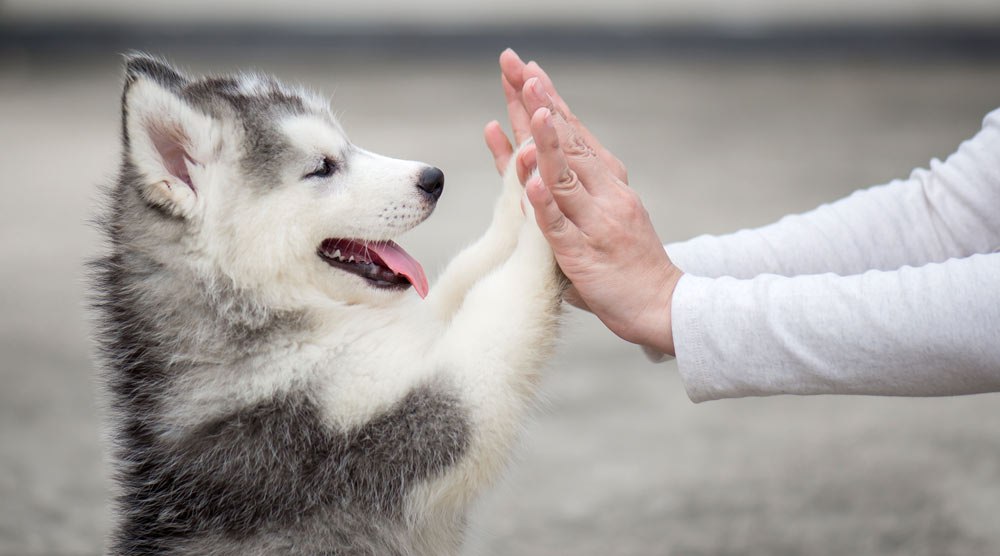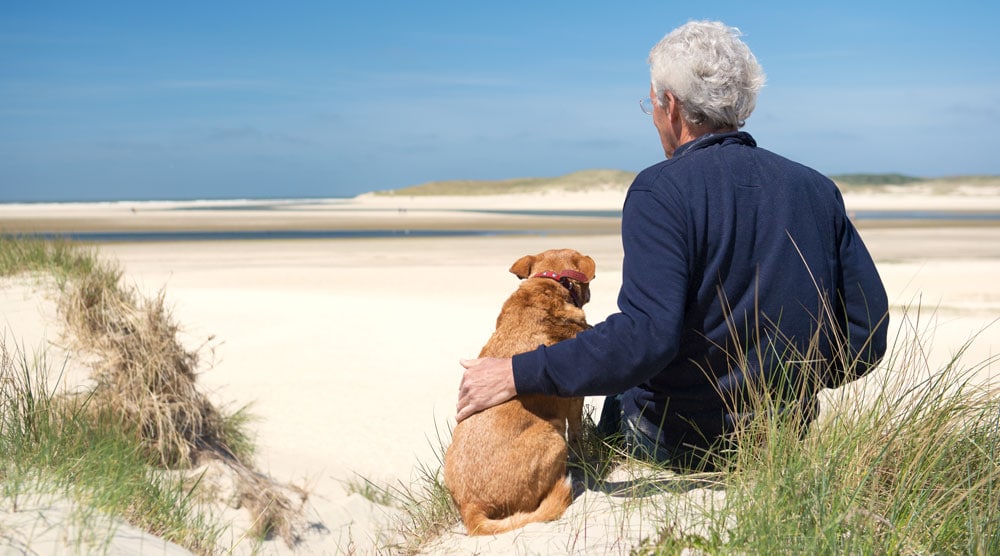If two (or more) dogs are part of your family, it’s natural to want to know whether they trust and like each other!
Fortunately, there are some easy ways to tell that dogs are bonded. These include giving affection, mutual grooming, and wanting to sleep together.
In this article, we’ll discuss what it means when dogs are bonded and how to spot the signs. We’ll also give you tips for encouraging the bonding process.
Contents
What Does It Mean When Dogs Are Bonded?

It’s common to hear about bonded dogs. But what does it really mean when two dogs are bonded to each other?
Many dogs are happy to be around other canines. They might even play with other dogs on walks, or tolerate a friend’s dog visiting the house.
However, bonded dogs have a close relationship that goes far beyond just tolerating each other’s presence. When bonded dogs are together, they provide each other with comfort, security, and happiness.
Any two dogs can become bonded, but the process usually requires living together for an extended time. It’s also sometimes seen in littermates, although not all dogs from the same litter are guaranteed to get along.
Tip: You’ll often hear the term “bonded pair” in a dog rescue environment. This is when two dogs are already close and need to be rehomed together.
8 Ways to Tell if Dogs Are Bonded to Each Other
Listed below are eight signs that two dogs are bonded. Remember that every canine relationship is different, so not all these signs will be present.
1. Always Spend Time Together
An obvious sign that dogs are bonded is that they always want to spend time together!
If two dogs choose to be close to each other regularly, then they are likely to be bonded. You’ll probably see them follow each other around the house or snuggle up together for a rest.
Of course, this doesn’t apply if the dogs are confined in the same small room. In this situation, the dogs may tolerate each other’s presence, but it doesn’t necessarily mean they are bonded.
2. Affectionate Physical Contact and Grooming
Puppies often lick the face and ears of their mother. This is thought to signal that the puppy wants to be fed, but it may also be a sign of appeasement.
The behaviour often continues into adulthood. When two dogs are close and bonded, they’ll lick each other’s muzzle to signal appeasement and companionship.
Two bonded dogs are also likely to be comfortable with physical contact. They probably won’t mind standing close to each other and may be happy to share a bed.
3. Sleep Together
Similarly to the last point, dogs that sleep together are likely to be bonded – especially if they snuggle up with actual physical contact.
Dogs are naturally wary of where they rest, as sleeping is a vulnerable state for any animal. If dogs sleep closely together, then this shows that they fully trust and feel comfortable with each other.
Tip: Even if your dogs choose to sleep together, it’s still important to provide separate beds. Sometimes the dogs may want space or alone time, so having separate resting spots can reduce tension.
4. Don’t Want to Leave House Without Each Other
Bonded dogs provide each other with comfort and security. This can make the dogs reluctant to leave the house without their friend.
Signs of anxiety include whining or other vocalisations, looking back at where the other dog was left, and lip licking.
It’s not unusual for dogs to be possessive of their toys. This is known as resource guarding, and it can lead to defensive behaviour or even fights.
Bonded dogs are more likely to be comfortable sharing their toys with each other. You’ll often see bonded dogs play tug of war with a toy, or take turns holding it.
This isn’t always the case though. Some dogs can be bonded, but still possessive of toys they consider to be “theirs”.
You shouldn’t try to force two dogs to share toys. If one (or both) of the dogs shows signs of resource guarding, such as growling when the other dog comes near, ensure you provide plenty of alternative toys. If this doesn’t solve the problem, then you may need to avoid giving the dogs toys when they are together.
6. Happy to Eat Together
As with toys, many dogs will guard their food. This is a natural behaviour that shouldn’t be punished, but it can lead to snarling, growling, or biting if another dog gets too near.
In some cases, a bonded dog will allow their friend to share food with them (or at least be nearby while they are both eating).
This is a sign of bonding, as dogs must have a strong connection to allow it. But sharing food is usually not a good idea – even with bonded dogs.
Just because a dog is not showing an outward sign of aggression doesn’t mean they are happy with the situation. There may be more subtle signs of stress, such as eating faster or having wide eyes.
For both dogs’ happiness and safety, it’s best to keep them separate at meal times.
7. Play Together
A common sign that two dogs are bonded is playing together. This might involve chasing each other, play fighting, or tug-of-war with a toy.
While canine play can be a positive thing, it’s important that the play is balanced and that both dogs enjoy it.
For example, there should be obvious turn-taking during the play session. This means that if the dogs play chase, they should take turns being the chaser.
It’s also important that either dog can end the play session when they’ve had enough. This is particularly important in a home environment, where the dog may not be able to move far away from the other.
When your dogs are playing, watch out for signs of stress, or that either dog is becoming overstimulated. These can include:
- Play becoming increasingly frantic or loud
- One of the dogs “telling off” the other
- One of the dogs trying to move away
- Lack of turn-taking
- Lip licking or drooling
- Excessive panting
- Tucked tail
If you notice that the play session is no longer balanced or fun for both dogs, it’s time to calmly separate them. This prevents the situation from causing stress or even escalating into a fight.
8. Signs of Stress or Anxiety When Separated
When two dogs are bonded, they often rely on each other for emotional support. This means they’ll take comfort and reassurance from the other dog’s presence, especially during difficult situations.
While it can be adorable when two dogs love each other, the downside is that they may feel stressed and anxious when separated.
There are always times when the dogs won’t be together. For example, you might need to take one dog to the vet or a groomer. If this separation causes intense anxiety and stress, it can make these events very difficult for both dogs.
For this reason, it’s important to teach your dogs that it’s OK to be apart. You can do this by separating the dogs for short periods, while providing lots of treats and reassurance to both.
How Long Does it Take for Dogs to Bond?
There’s no set time for how long it takes two dogs to bond, but it typically takes much longer than many people realise.
As a general rule, you should expect it to take around three months for dogs to feel comfortable living together.
It can take a lot longer for dogs to become fully bonded though. While some dogs may bond within 6 months, it’s not unusual for the process to take several years.
Additionally, bonding isn’t guaranteed when you introduce a new dog into the home. Some dogs live together for a long time without showing the signs of bonding mentioned in this article.
Tips for Helping The Bonding Process
If you’re introducing a new dog into the household, there are many ways you can encourage the bonding process with your existing pet. Here are a few tips:
- Don’t assume that the dogs will naturally bond if given enough time. Be proactive in creating a positive and relaxed environment that provides the best chance of bonding.
- Ensure that the dogs have separate beds and areas to rest. Not having enough space is a common cause of frustration and stress, which can interfere with the bonding process.
- Don’t allow play to become too rough or one-sided. It’s important that interactions between the dogs are positive and enjoyable.
- If you’re introducing a puppy to an adult dog, make sure that play sessions are kept short. Adult dogs have much less stamina for play, and puppies often don’t understand when the other dog has had enough. Avoid letting the play continue until the adult dog tells off the puppy, as this can affect their bond. It can even cause the puppy to develop a fear of dogs, as they are at an impressionable age.
- Make sure the dogs are used to spending time apart. This can prevent future anxiety or stress when they must be separated for vet trips or grooming.
- Feed the dogs separately. This prevents either dog from feeling rushed or stressed at meal times.
Summary
There are many signs that two dogs are bonded. These include spending time together, sleeping in the same bed, and playing. Bonded dogs may also become stressed or anxious when they are apart.
Do you have any questions about how to tell if two dogs are bonded to each other? Please let us know in the comments below.



